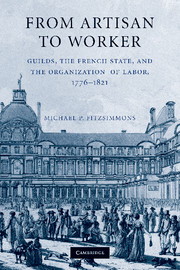1 - The Decline and Demise of Guilds, 1776–1791
Published online by Cambridge University Press: 06 July 2010
Summary
Your committee believed that it should link the existence of this tax to a great benefit done for industry and commerce, the suppression of masterships and guilds that your good sense should abolish for the sole reason that they are exclusive privileges.
– d'Allarde, spokesman for the Committee on Taxation, to the National Assembly, February 15, 1791During the eighteenth century many guilds became increasingly enfeebled because of external competition, internal divisions and other developments, but the decisive event in their decline was their dissolution in 1776, after which they fell away precipitously until their final suppression in early 1791. Although the Crown, after only a few months, retracted the edict of Controller-General Anne-Robert-Jacques Turgot that had abolished corporations, the reorganized bodies were left weakened and ill prepared to meet the challenges posed by the French Revolution, which brought about their final abolition.
GUILDS UNDER THE OLD REGIME
By the latter part of the eighteenth century, guilds had long been a prominent feature of urban life. Many of them had been in existence for centuries – in Paris the corporation of linen makers claimed to have statutes dating from 1278 and that of vinegar makers from 1294. The guild of bakers in Paris had statutes from 1290, but claimed foundations in the Gallo-Roman period. Not all corporations could claim such venerable lineage, of course, but the entire system of guilds was deeply woven into the fabric of urban life, from large cities to smaller towns.
- Type
- Chapter
- Information
- From Artisan to WorkerGuilds, the French State, and the Organization of Labor, 1776–1821, pp. 7 - 57Publisher: Cambridge University PressPrint publication year: 2010



